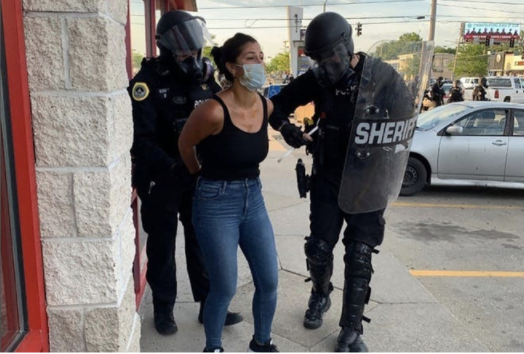Maced and detained: Journalist shares her experience with police during Black Lives Matter protest

Andrea Sahouri, a Des Moines Register reporter, was arrested while covering a Black Lives Matter protest.
April 15, 2021
Des Moines Register journalist Andrea Sahouri told her story in an interview about covering the Black Lives Matter protests during summer 2020 during First Amendment Days on Thursday.
In her first year out of the Columbia Graduate School of Journalism and a reporter for the Des Moines Register, Sahouri was arrested and faced up to 30 days in jail, something that was never taught in college nor in her job description as a beat reporter.
Six days after the police killing of George Floyd, protests erupted across the country.
After branching off to a nearby Verizon parking lot where she could regroup and avoid the chaos, she saw Des Moines police officer Luke Wilson.
“I look behind me, and all of a sudden, I see an officer charging right at me,” Sahouri said.
Sahouri said she was press and raised her hands toward the officer. The officer grabbed Sahouri and maced her at close range.
With pepper spray stinging her eyes, her hands zip tied behind her back and then caged up in the back of a police van, this would be a day Sahouri would never forget, she said.
Once in the back of the police van and dealing with the traumatic experience of being arrested, Sahouri kept her journalist mindset and was able to retrieve her phone and livestream the protest from the van. As the van departed the protest and traveled to Polk County Jail, Sahouri was put into police custody.
It was revealed that the Des Moines Police Department did not have a formal crowd control policy at the time.
“It seems that any kind of assembly immediately is seen as unlawful, and that is scary because people are angry about what is going on in their communities, and they have a right to be angry,” Sahouri said. “… From what I witnessed in Des Moines specifically, it was a few throwing rocks and water bottles and sometimes bricks, but the majority is people engaging in free speech and trying to show that they are in pain and they are trying to speak out against racism.”
Later in her story, she spoke about the consequences of her arrest. While Sahouri, who is a person of color, was arrested, her co-reporter, who is white, was allowed to walk away from the situation. Sahouri was asked and spoke on what would have happened if the roles were reversed.
While she is unsure what exactly would have happened, Sahouri just points to the proof.
“I don’t know why I was not allowed to go,” Sahouri said. We were both dressed the same. … I can’t really tell you what would have happened, but what did happen says a lot.”
During her arrest, Sahouri and her partner, the Des Moines Register’s Katie Akin, told police several times they were journalists from the Des Moines Register.
“To me, it was pretty clear that they knew I was a journalist, and they didn’t care,” Souhari said.
Sahouri still feels the burnout and anxiety of her arrest from time to time. At the end of the conversation, Sahouri spoke about what it is like to be a journalist of color.
“To hear Brooklyn Center police saying that journalists need to leave the area or you will get arrested is scary because [journalists] are there to document what protesters are doing and what police are doing,” Sahouri said.
Sahouri offered advice to aspiring journalists to be OK with being afraid, but never let your source — in her case, the police — dictate coverage. While the divide between journalists and police is still prevalent, Sahouri hopes police departments see journalists are not the enemy.
“Journalists of color are even more careful to be seen as not biased because we don’t necessarily get that white centric, apparently inherent objectivity for being a white individual,” Sahouri said. “Journalists of color definitely have that burden of feeling, ‘Will I be seen as biased because of my identity?’”






